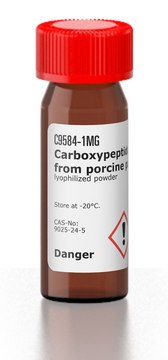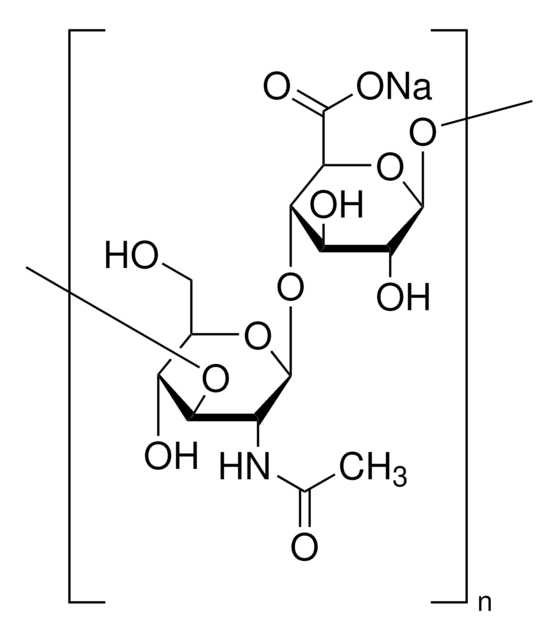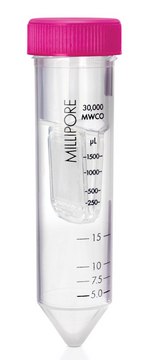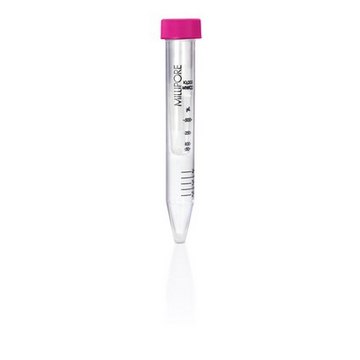SML2988
Tat-NR2B9c trifluoroacetate
≥95% (HPLC)
Synonym(s):
NA-1, trifluoroacetate salt, Tyr-Gly-Arg-Lys-Lys-Arg-Arg-Gln-Arg-Arg-Arg-Lys-Leu-Ser-Ser-Ile-Glu-Ser-Asp-Val, trifluoroacetate salt, YGRKKRRQRRR-KLSSIESDV, trifluoroacetate salt
Sign Into View Organizational & Contract Pricing
All Photos(1)
About This Item
Empirical Formula (Hill Notation):
C105H188N42O30 · xC2HF3O2
CAS Number:
Molecular Weight:
2518.88 (free base basis)
UNSPSC Code:
12352200
NACRES:
NA.77
Recommended Products
Biochem/physiol Actions
Tat-NR2B9c (NA-1) is a 20-mer peptide composed of a membrane-permeant HIV-1 Tat protein transduction domain sequence (a.a. 47-57) N-terminal to the NMDA receptor (NMDAR) GluN2B carboxyl tail sequence KLSSIESDV that blocks intracellular NMDAR-PSD-95 interaction-induced neurotoxic signaling without affecting NMDAR-mediated synaptic activity or calcium influx. NA-1 protects cultured cortical neurons from NMDA excitotoxicity (50 nM; 20/40/100 μM NMDA) and reduces focal ischemic brain damage in rats in vivo (3 μmol/kg iv. bolus 1 hr post MCAO onset).
Storage Class Code
11 - Combustible Solids
WGK
WGK 3
Flash Point(F)
Not applicable
Flash Point(C)
Not applicable
Regulatory Information
新产品
Choose from one of the most recent versions:
Certificates of Analysis (COA)
Lot/Batch Number
Don't see the Right Version?
If you require a particular version, you can look up a specific certificate by the Lot or Batch number.
Already Own This Product?
Find documentation for the products that you have recently purchased in the Document Library.
Yanting Chen et al.
Journal of cerebral blood flow and metabolism : official journal of the International Society of Cerebral Blood Flow and Metabolism, 35(5), 739-742 (2015-02-12)
The Tat-NR2B9c peptide has shown clinical efficacy as a neuroprotective agent in acute stroke. Tat-NR2B9c is designed to prevent nitric oxide (NO) production by preventing postsynaptic density protein 95 (PSD-95) binding to N-methyl-D-aspartate (NMDA) receptors and neuronal nitric oxide synthase;
Luka R Srejic et al.
Journal of cerebral blood flow and metabolism : official journal of the International Society of Cerebral Blood Flow and Metabolism, 33(12), 1937-1943 (2013-09-12)
Since the most significant ischemic sequelae occur within hours of stroke, it is necessary to understand how neuronal function changes during this time. While histologic and behavioral models show the extent of stroke-related damage, only in vivo recordings can illustrate
Michelle Aarts et al.
Science (New York, N.Y.), 298(5594), 846-850 (2002-10-26)
N-methyl-D-aspartate receptors (NMDARs) mediate ischemic brain damage but also mediate essential neuronal excitation. To treat stroke without blocking NMDARs, we transduced neurons with peptides that disrupted the interaction of NMDARs with the postsynaptic density protein PSD-95. This procedure dissociated NMDARs
Lucy M Teves et al.
Journal of cerebral blood flow and metabolism : official journal of the International Society of Cerebral Blood Flow and Metabolism, 36(3), 555-561 (2015-12-15)
Tat-NR2B9c, a clinical-stage stroke neuroprotectant validated in rats and primates, was recently deemed ineffective in mice. To evaluate this discrepancy, we conducted studies in mice subjected to temporary middle cerebral artery occlusion (tMCAO) for either 30 or 60 min according to
Diego Milani et al.
Neuroscience research, 114, 9-15 (2016-09-19)
We examined the efficacy of R18 in a transient MCAO model and compared its effectiveness to the well-characterized neuroprotective NA-1 peptide. R18 and NA-1 peptides were administered intravenously (30, 100, 300, 1000nmol/kg), 60min after the onset of 90min of MCAO.
Our team of scientists has experience in all areas of research including Life Science, Material Science, Chemical Synthesis, Chromatography, Analytical and many others.
Contact Technical Service







